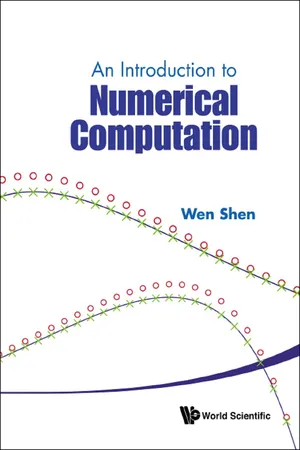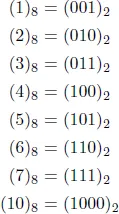
- 268 pages
- English
- ePUB (mobile friendly)
- Available on iOS & Android
An Introduction to Numerical Computation
About this book
Developed during ten years of teaching experience, this book serves as a set of lecture notes for an introductory course on numerical computation, at the senior undergraduate level. These notes contain the material that can be covered in a semester, together with a few optional sections for additional reading. Rather than surveying a large number of algorithms, the book presents the most important computational methods and emphasizes the underlying mathematical ideas. In most chapters, graphs and drawings are relied on, to build up intuition.
The notes are written in a rather colloquial style, presenting the subject matter in the same form as it can be explained in a classroom. For instructors, this will minimize the amount of effort required to prepare their blackboard presentations.
As prerequisites, the book only relies on standard calculus, an introductory course on matrices, and some basic computer programming skills. As a new feature, these notes are supplemented by two sets of videos from the author's Youtube channel. These videos contain a complete set of live lectures given in Spring 2015, together with a complete set of short tutorials, from 5 to 15 minutes each.
A set of homework problems is included at the end of each chapter. Homework projects cover a variety of applications, in connection with population dynamics, engineering, mechanics, image reconstruction, etc. A complete set of solutions is available for instructors, upon request.
Request Inspection Copy
Developed during ten years of teaching experience, this book serves as a set of lecture notes for an introductory course on numerical computation, at the senior undergraduate level. These notes contain the material that can be covered in a semester, together with a few optional sections for additional reading. Rather than surveying a large number of algorithms, the book presents the most important computational methods and emphasizes the underlying mathematical ideas. In most chapters, graphs and drawings are relied on, to build up intuition.
The notes are written in a rather colloquial style, presenting the subject matter in the same form as it can be explained in a classroom. For instructors, this will minimize the amount of effort required to prepare their blackboard presentations.
As prerequisites, the book only relies on standard calculus, an introductory course on matrices, and some basic computer programming skills. As a new feature, these notes are supplemented by two sets of videos from the author's Youtube channel. These videos contain a complete set of live lectures given in Spring 2015, together with a complete set of short tutorials, from 5 to 15 minutes each.
A set of homework problems is included at the end of each chapter. Homework projects cover a variety of applications, in connection with population dynamics, engineering, mechanics, image reconstruction, etc. A complete set of solutions is available for instructors, upon request.
Request Inspection Copy
Readership: Junior or senior undergraduate students interested in numerical computation and analysis, majoring in mathematics, computer science, physics, engineering, etc.
Key Features:
- Matlab is integrated throughout the book
- The book assumes minimum prior mathematical knowledge
- The book was class-tested through 5 semesters at Penn State University, with top reviews from students
- Supplementary videos offer an enrichment to these lecture notes
Frequently asked questions
- Essential is ideal for learners and professionals who enjoy exploring a wide range of subjects. Access the Essential Library with 800,000+ trusted titles and best-sellers across business, personal growth, and the humanities. Includes unlimited reading time and Standard Read Aloud voice.
- Complete: Perfect for advanced learners and researchers needing full, unrestricted access. Unlock 1.4M+ books across hundreds of subjects, including academic and specialized titles. The Complete Plan also includes advanced features like Premium Read Aloud and Research Assistant.
Please note we cannot support devices running on iOS 13 and Android 7 or earlier. Learn more about using the app.
Information
Chapter 1
Computer Arithmetic
1.1Introduction
1.2Representation of Numbers in Different Bases
| 10: | decimal, which has become standard nowadays; |
| 2: | binary, computer use; |
| 8: | octal; |
| 16: | hexadecimal, used in ancient China; |
| 20: | vigesimal, used in ancient France (numbers 70 to 79 are counted as 60+10 to 60+19 in French, and 80 is 4 × 20); |
| 60: | sexagesimal, used by the Babylonians. |





Table of contents
- Cover Page
- Title Page
- Copyright Page
- Dedication
- Preface
- Contents
- 1 Computer Arithmetic
- 2 Polynomial Interpolation
- 3 Piecewise Polynomial Interpolation: Splines
- 4 Numerical Integration
- 5 Numerical Solutions of Non-linear Equations
- 6 Direct Methods for Systems of Linear Equations
- 7 Fixed Point Iterative Solvers for Linear Systems
- 8 The Method of Least Squares
- 9 Numerical Solutions of ODEs
- 10 Two-Point Boundary Value Problems
- 11 FDM for Partial Differential Equations
- Bibliography
- Index